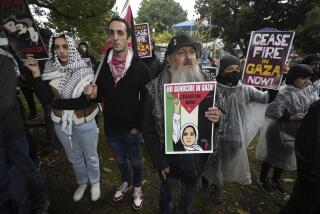Ramallah Residents See Dreams Crumble
RAMALLAH, West Bank — For Palestinians, this city of 60,000 residents--many of them affluent, well-traveled, schooled in the U.S.--was the de facto capital of Palestine. It was the bustling economic and political hub of what they assumed would one day soon be a sovereign state.
There were Internet cafes, a stock exchange and fancy residential villas.
Ramallah is today under siege by the Israeli army. Tanks slice the pavement and residents huddle in their homes as Palestinian gunmen and Israeli soldiers turn the city center into a war zone. It is as though the clock has been turned back decades, residents say.
As the power base of Palestinian Authority President Yasser Arafat, Ramallah became the haunt of militants who are attacking Israeli citizens. Among them, Marwan Barghouti, a militia commander with Arafat’s Fatah movement, gained prominence after the current conflict exploded in September 2000. Ramallah is his home base, from which Israeli authorities believe he launches many a militia operation.
Israel’s decision to reoccupy Ramallah, with the stated goal of capturing militants and destroying their weapons, was a show of force that dealt a huge psychological blow to many residents. Since the invasion was launched Monday night, few have been able to venture outdoors. Some have lost electricity or water. Life is frozen in time.
“I was expecting peace and that we’d gain our freedom,” said Omar Kamal, a 55-year-old accountant, describing the aspirations that he and others had not more than two years ago. “Ramallah was going to be a more outward-looking city. I expected it to grow more and more. But now the situation is very, very bad.”
Kamal and his family tiptoed Wednesday into their frontyard, a well-manicured plot of pear trees and pink rosebushes, to watch two Israeli Apache attack helicopters dart in the sky, the thump-thump audible even after the aircraft dipped behind puffy white clouds.
Kamal’s two sons go to university but often can’t reach their classes because of Israeli roadblocks and closures. He has owned the house that his father built for more than 30 years. But his face is worn and he smokes nervously; no one has gotten much sleep since the military operation began. His 75-year-old mother, Nadieh, worriedly fingered six bottles of medicine she needs for a heart condition, afraid she will run out.
“There is still hope,” Kamal said. “Hopefully, we are in our last hour and someone will feel for us and intervene, before we sink to the very bottom, to the point of no return.”
The Kamals live a stone’s throw from Arafat’s headquarters, so they’re hoping that will protect them. Though maybe it makes them a target.
In addition to Ramallah’s 60,000 residents, about 140,000 more people live in the county, which includes several outlying villages. Before the current uprising, Ramallah was a rare Palestinian city visited by Israeli Jews, who ate at its restaurants and heard music in its clubs. That ended about the time Palestinians lynched two Israeli reservists near Ramallah’s downtown Manara Square, scarcely two weeks into the current uprising.
On the eastern side of Ramallah, the Al Sarafandy Bakery on Wednesday managed to fire up its ovens and bake bread for the first time in two days. Dozens of people risked leaving their homes and crowded into the small storefront, stocking up on plenty of pita. The shoppers were, unusually, men for the most part; women were too afraid to venture out, they said.
“We want to feed people,” said Sam Ali, a Palestinian American and veteran of the U.S. Air Force, who owns the building in which the bakery operates. He sat behind a low wooden counter to help handle the crowd.
After 45 years in Boston, Ali returned to Ramallah in 1995. That was around the time Israel was ending its military occupation of the city and turning it over to the control of Arafat’s Palestinian Authority, established under landmark Oslo peace accords that were supposed to govern Israeli-Palestinian coexistence and settle the conflict. The 1993 accords and many of the notions enshrined in them now are dead.
Ali said two of his U.S.-born sons came to Ramallah as well, intending to cast their lot with the emerging Palestinian state. Both left in disgust.
Customers in the bakery were loading up with as much bread as they could carry. Bahieh Deib, a squat, 50-year-old woman dressed in a traditional Palestinian embroidered gown, walked about two miles to pick up pita for her family and her neighbors.
“People are afraid to come out,” she said. “I came by myself, and everyone gave me money to buy bread.” She plunked down 25 Israeli shekels--about $5.40--for 150 pieces of pita.
Several blocks away, four men in their 20s strode down the street, looking for a way, they said, to “resist.” They said Israeli Prime Minister Ariel Sharon’s decision to invade Ramallah will only strengthen Palestinian defiance. In the meantime, a truce is out of the question.
“If Abu Amar [Arafat] believes we should lay down our weapons, we will,” said Mohammed Mansour, 25, who studied fashion design until he ran out of money and became a construction worker. “But we will not surrender weapons only to start a political process that will deceive us, like every other time.
“If we hand in our weapons and get cheated again,” he added, “we will sell everything and get weapons again and resist again.”
More to Read
Sign up for Essential California
The most important California stories and recommendations in your inbox every morning.
You may occasionally receive promotional content from the Los Angeles Times.











